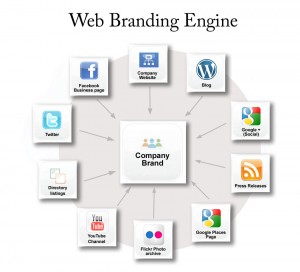
Categories:
Cross-platform branding, also known as multi-platform branding, is easy to say (sort of), but difficult to do. The practice entails the consistent delivery of brand messages and images across traditional media platforms as well as digital media platforms to achieve client objectives. Successful implementation requires professionals from a variety of disciplines – from marketing strategists and creative professionals to digital media campaign managers, content developers and web marketing specialists – to work together seamlessly while maximizing their own specialized talents for client benefit.
Five years ago brand marketing was a “simpler” endeavor. Integrated marketing communications – the analog precursor to cross-platform branding – required strategists, creatives, media planners and public relations folks to understand overall client objectives, strategies and messages and to deliver those messages effectively in familiar media outlets. Media planners executed print, radio and broadcast buys; creative professionals delivered print ads, radio and television spots; while public relations pros pitched companion stories to a broad range of mostly traditional media outlets. Sometimes, these integrated campaigns involved the website, but more often than not, the website tended to be more of an afterthought than a centerpiece of the overall branding campaign. The account strategist watched over the campaign, communicated with the client and watched for anecdotal evidence that the brand campaign was “working.”

With the Great Recession of 2008-09 came a commensurate shift in client appetites for branding campaigns. If the old adage was that “50% of your advertising is working,” clients demanded to know which 50% was working and to make it immediately 100% and at less than 50% of the previous year’s budget. More often than not, the advertising that was working – or at least was easily measurable – was in the digital space with Google Adwords campaigns and search engine optimization leading the way. Real time analytics and conversion metrics such as click-thu rate, conversion, leads and sales took precedence over lagging metrics like brand awareness, impressions, reach and frequency.
Agile branding agencies responded with digital offerings or perished along with the recession. Smart clients realized the importance of keeping up brand awareness during difficult economic times and took advantage of lower prices and less competition in traditional media outlets while siding with branding agencies that could help them navigate the digital and emerging social media waters.
So, where to begin in this brave new digital and social media world?
As always, the best place to start is with the fundamentals of the marketing process. Despite the shift in brand communication vehicles, understanding the fundamentals of client objectives, target audience and brand differentiation is just as core to advancing the cross-platform branding process as it was in executing an integrated communications campaign in the “analog age.” The difference now is that the number of choices available to achieve objectives and to reach the target audience have increased both in number and in complexity.
So, the smart marketer simplifies the process by beginning with marketing fundamentals. What are you trying to achieve with your marketing and branding initiatives? Who are you trying to reach? What do you want your target audience to do? How are you different/more desirable than your
competition? How will you know?
Marketing objectives often include building brand awareness, competitive differentiation as well as conversion actions such as lead generation and sales. Knowing how to reach the target audience cost effectively with compelling messages and images that cut through the clutter to create quantifiable action is the challenging work of the multi-platform branding agency.
The emergence of digital advertising platforms such as Facebook, Twitter, and Google display advertising both enhance the choices of the brand marketer and provide advanced targeting tools.
Take Facebook as an example. Facebook’s advertising tools allow marketers to target age, geography, and an almost infinite number of user interests. With Facebook advertising tools, a multi-sport coaching company seeking to reach elite female triathlete’s aged 40-44, in New England can attract an audience of roughly 40,000 prospects with messages designed to generate Facebook likes at an average cost of less than $1.00 per Like. Of course, this begs the question of what a brand does with the likes it generates, but that’s a topic for another day.
Likewise, a financial services firm can reach visitors to its website within the last 30 days with branded Google remarketing ads designed to create awareness and registrations for a lunch and learn workshop. But how does that same firm use other marketing tools to bring the visitor to the website in the first place? Again, this may be a topic for another day, along with content marketing, the sales funnel, lead generation and sales.
Yes, digital tools are highly advanced in reaching micro audiences for brands. But traditional marketing tools continue to play a vital role in the overall marketing communications process. A lifecare retirement community, for example, has developed a leads database of over 6,000 names with both physical and email addresses using a mix of traditional and digital advertising vehicles. When the community wants to know how to reach a subset of that audience for immediately available cottage residences, a Nielsen Prizm cluster analysis of recent buyers compared to its leads database may drive an effective direct mail and companion email campaign to flush out potential buyers.
Knowing which tools to deploy, when, and for what purpose is the role of the cross-platform branding agency. How does it all work? Which tools are best to reach your customers and prospects?
Have a question? Ask us on Twitter @ethosmarketing.
For a complimentary consultation, please contact Ted Darling at tdarling@ethos-marketing.com.
About Ethos
Ethos is a multiplatform branding agency that develops and executes integrated marketing campaigns across multiple channels for companies inside and outside of Maine.
At Ethos, we believe that the most effective way to set a company’s marketing course is by finding its core truth – its ethos. We know that once we discover and communicate that core truth, we can truly make a difference for each client’s unique marketing and business objectives.
With Ethos, you get more than a marketing agency. You get a long-term partner whose goals are your goals.
Learn more about the Ethos approach and the work we’ve done for our clients. Want to have a conversation about your brand’s core truth? Contact us!

